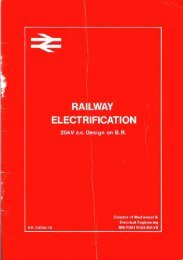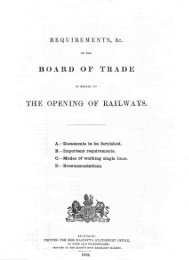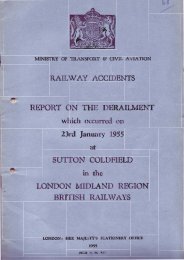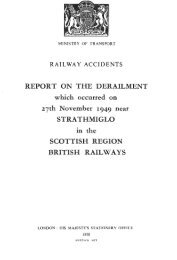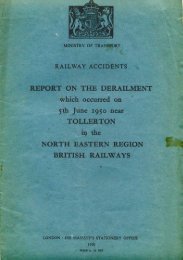R A I LT R AC K - The Railways Archive
R A I LT R AC K - The Railways Archive
R A I LT R AC K - The Railways Archive
You also want an ePaper? Increase the reach of your titles
YUMPU automatically turns print PDFs into web optimized ePapers that Google loves.
Route characteristics<br />
DESCRIPTION <strong>The</strong> North Trans-Pennine (NTP) Route forms the primary<br />
corridor across the Pennines encompassing the main conurbations of Liverpool,<br />
Manchester and Leeds, and linking them to Hull, York and Scarborough. <strong>The</strong><br />
route also includes the Wolds Coast route from Hull to Scarborough and the<br />
Calder Valley via Bradford to Hebden Bridge. <strong>The</strong> route is predominantly two<br />
track with 90mph linespeed east of Huddersfield and 85mph between Liverpool<br />
and Manchester.<br />
BOTTLENECK ANALYSIS Capacity on the route is constrained by the<br />
bottlenecks at Leeds, and in the Manchester area between Deansgate and<br />
Piccadilly.<br />
<strong>The</strong> Leeds node is constrained by the number of available paths through<br />
the four-track layout at the west end of the station and the two-track layout at<br />
the east end. This congestion is further aggravated by the number of platforms<br />
and the 15mph and 10mph speed restrictions at the west and east end,<br />
respectively. Further constraints are the signalling system and the style of traffic<br />
operating through the node, which is entirely different from what it was when<br />
the layout was last modified in the 1960s.<br />
Following detailed analysis and consultations with our customers, we have<br />
committed to major remodelling of Leeds West End Junction, minor<br />
Route vision<br />
<strong>The</strong> increasing congestion on the adjacent road networks, particularly the M62,<br />
represents a major opportunity for this route. Following our route strategy work,<br />
our intention is to expand the rail market by providing for a high-capacity, fast,<br />
interurban route linking Liverpool, Manchester, Leeds and York–Hull.<br />
<strong>The</strong> cornerstone to the future of the Trans-Pennine Route is the major<br />
work we have started at Leeds. Contracts have already been let and work has<br />
started on this development. <strong>The</strong> west end approaches to the station will be<br />
completely rebuilt in order to replace the existing constrained four-track layout<br />
with a higher-speed six-track layout. <strong>The</strong>se six tracks will serve the three key<br />
flows into the station from Wakefield and south London (Route 2), Huddersfield<br />
and west Manchester (this Route) and the Airedale–Wharfedale–Harrogate<br />
commuter corridors (Route 36). <strong>The</strong> track layout at the east end of Leeds<br />
Station will also be remodelled to improve journeys to York, the North East and<br />
the important train maintenance depot at Neville Hill. In total the new layout will<br />
Route development and customer requirements<br />
<strong>The</strong> stations on the route are in good order following our major renewal<br />
programme. We are improving accessibility at Halifax and Dewsbury by installing<br />
new lifts in partnership with our customer, local authorities and the PTE. We are<br />
investigating the potential of parkway stations on the route, which aim to get<br />
people out of their cars and on to the railway. In particular, we have purchased<br />
land to secure a station site on the M60 to serve people living in south and<br />
east Manchester.<br />
Freight traffic on the route is growing, particularly in chemicals and<br />
intermodal traffic. We intend to develop the capacity across the Pennines to<br />
serve the dual needs of passenger and freight markets. We propose to increase<br />
the gauge of this route to W10, and work is in hand to develop this.<br />
Finally, to develop further capacity, faster journeys and new train services<br />
across the Pennines, we are considering the route via Huddersfield to<br />
Manchester Piccadilly, together with the route via the Calder Valley and Hebden<br />
Bridge to Manchester Victoria (part of Route 33). We are promoting solutions<br />
remodelling at the east end of Leeds Station with three new platforms and<br />
renewal of the signalling equipment in the area. This is a major part of our ‘Leeds<br />
1st’ project, which also includes complete upgrading of passenger facilities<br />
throughout the station. <strong>The</strong> remodelling of the track will give a 50%-per-hour<br />
increase in capacity through the western approach to the station.<br />
Our analysis and further work proposals for the Manchester area are set<br />
out in Route 1.<br />
MAJOR STATIONS<br />
Leeds Works completed on the station’s north concourse provide additional car<br />
parking and improved retail opportunities. In parallel with the major track<br />
capacity enhancement work, Leeds Station will be substantially rebuilt with new<br />
platforms and a new roof. A priority in the rebuilding is to improve the<br />
accessibility of the platforms for all passengers, including the disabled and those<br />
with luggage or small children. Platforms will be linked by a new overbridge and<br />
lifts. <strong>The</strong> platforms will be resurfaced, lighting renewed, and customer-information<br />
displays will be replaced with state-of-the-art equipment. Customer facilities will<br />
be developed, including improved interchange facilities between rail and bus,<br />
additional car parking, new lounges and ticketing and information facilities.<br />
allow up to 50% more trains per hour to serve Leeds from the west as opposed<br />
to the current 24 trains. Overall, the ‘Leeds 1st’ project will benefit Leeds and<br />
Yorkshire for many years to come by providing for more, and faster train<br />
services, as well as improving punctuality.<br />
Across the North Trans-Pennine Route we also intend to improve<br />
passenger journey times, first by targeting the link between Liverpool, Manchester<br />
and Leeds. Journey times will be improved in the May timetable by taking<br />
advantage of the reconstruction of Irlam Viaduct (between Manchester and<br />
Warrington) which will be completed this spring. Beyond this, we have a set<br />
target time of 52 minutes on the Leeds–Manchester section of the route. <strong>The</strong><br />
‘Leeds 1st’ scheme will contribute towards meeting this objective. In the longer<br />
term, we are aiming to reduce the Leeds–Manchester journey time to around<br />
45 minutes to meet market, Franchising Director and customer requirements.<br />
that aim to provide four fast trains per hour between Leeds and Manchester with<br />
a 45-minute journey time. Our proposed solutions will address timetable service<br />
patterns, infrastructure enhancements and the linking of the Manchester stations,<br />
the development of the infrastructure to allow better integration of services on<br />
the North Trans-Pennine, Calder Valley, Warrington Central and Chat Moss<br />
routes, without compromising traffic growth on any of these individual routes.<br />
We will complete this detailed study, after working closely with our<br />
customers, the Franchising Director and the PTEs, and will report on the results<br />
in the next NMS.<br />
This is part of a major Midlands and Northern England timetable study for<br />
2003 and beyond to ensure all of our customers aspirations can be met and any<br />
necessary infrastructure enhancements identified, agreed and completed before<br />
2003. This incudes the future timetable structure and infrastructure capacity<br />
between Leeds and Hull.<br />
185



